LAST UPDATE | 6 Feb 2022
PICKING UP WHERE they left off in November, some of the interplay between Ireland’s forwards and backs during yesterday’s 29-7 bonus-point win over Wales was superb.
The Welsh defence struggled to cope at times as Andy Farrell’s side produced nine clean linebreaks in another balanced attacking performance.
Ireland weren’t as clinical as they would have liked. Leaving the Wales 22 without scoring on nine different occasions means they have plenty of room to improve for next weekend’s visit to Paris to take on France.
But when Ireland clicked, they were excellent and the varied skillsets of their forwards was a big point of difference again. The Irish forwards are threats with both their ball-carrying and their passing, meaning that Wales struggled to deal with them.
All eight of Ireland’s starting pack yesterday are good ball-carriers, some of them outstanding.
Take, for example, back row Caelan Doris who delivered another muscular showing yesterday.
We see a strong carry from Doris above as he brings ‘feet, fight, and finish’ to the party.
Having ensured he is actually running onto the ball when he receives it, the burst of footwork from Doris pre-contact allows him to dictate where and how the tackle will take place.
Doris fights to drive his legs once contact has been made.
And then he does his best on the ground to finish in a good position, twice hitching himself with his legs to ensure he can present the ball cleanly for scrum-half Jamison Gibson-Park.
With Rónan Kelleher and Josh van der Flier doing good work in clearing out the breakdown, it means lightning-quick ball for Ireland, which they had more than 70% of the time yesterday.
Ireland’s pack is powerful, but they bring subtlety to their carrying. We get another example below as replacement hooker Dan Sheehan shows excellent footwork pre-contact to beat Aaron Wainwright before powering forward.
Sheehan does his best to roll onto the ball after working around the corner, then shows that same sequence of feet, fight, finish to win the gainline for Ireland.
Of course, sometimes Ireland’s forwards are more direct in their ball-carrying, as in the instance below from Tadhg Furlong.
Furlong spots Wales scrum-half Tomos Williams in the defensive line here and accelerates gleefully into the mismatch without turning on the footwork on this occasion.
What we’ve established here is that Ireland’s forwards are all well capable as ball-carriers, so the defence obviously has to respect that threat close in to the breakdown.
The fact that all of Ireland’s forwards are also capable of passing the ball and running really convincing decoy lines means that things get even trickier for the defence.
Let’s take Bundee Aki’s early try yesterday as an example.
The Irish forwards nail their lineout drill and then use a ‘maul break’ play as van der Flier breaks off to the right and passes to Doris for a big carry.
Van der Flier’s arcing line is crucial as it takes him outside the first three Welsh defenders off the maul, allowing Doris to get a direct one-on-one against out-half Dan Biggar, an obvious mismatch.
Johnny Sexton bounces out the back of Doris for a possible pullback pass from van der Flier, ensuring that Wales inside centre Nick Tompkins can’t turn in to help Biggar with the tackle on Doris.
Getting over the gainline like this on first phase makes everything that follows easier, with Wales immediately playing catch-up in defence.
Garry Ringrose and Furlong make carries to the right off Gibson-Park on the next two phases and even as Furlong carries, we can see Sexton directing play back to the left.
The response from Ireland’s forwards is perfect as Sexton and Mack Hansen swing back to the left – the Connacht wing has already worked across to the right and Ireland might even have scored earlier thank to his movement.
Tadhg Beirne steps up as the central forward in a 3-man pod [red below] to the left, with James Ryan getting back to his feet to slot onto the inside of Beirne and Kelleher lining up on Beirne’s outside.
Obviously, Ireland could make a simple carry off Gibson-Park here but instead Beirne uses his passing skill to link the ball out the back to Sexton in motion for what proves to be a lovely try.
Clearly, the passes from Beirne, Sexton, and Hansen are crucial but there is also vital off-the-ball work from Kelleher and Doris.
First, Kelleher [yellow below] holds his feet and times his run to the outside of Beirne to be a viable option for a short tip-on pass. The threat of Kelleher running at the line drags in Wales centre Tompkins.
After Beirne throws the link pass to Sexton out the back, Doris’ timing is also good as he is a viable front-door passing option for the Ireland out-half.
Doris’ run [red below] drags Wales scrum-half Williams inwards, just as Kelleher’s did with Tompkins.
It all adds up to leave Wales short on the edge and Hansen is able to float the ball over Louis Rees-Zammit’s head to find Aki, who has been holding width on the left after initially clearing out the breakdown over Doris’ carry 20 seconds earlier.
Wales’ defence is poor here – they needed to react better to Sexton and Hansen’s swing back to the left – but they also have to respect the ball-carrying threats of Beirne, Kelleher and Doris, leaving them short out wide.
The link passing of Ireland’s forwards was sharp throughout this game, with Furlong delivering the most eye-catching example in the first half.
Again, Sexton is the director of play here, signalling that he wants to bounce back to their right after identifying the opportunity to create a numbers-up attacking situation.
Furlong puts his hand up as the central figure in a 3-man pod with van der Flier and Ryan either side of him, as Sexton swings across to take up the ‘release’ position out the back.
Furlong is a convincing ball-carrying threat here, accelerating aggressively at the defence and staying ‘square’ upfield, not giving them early cues that he’s going to pass. Ryan on his outside is also a viable tip-on pass option.
When Furlong does release a beautiful no-look pass to Sexton at the last second, he has already helped to hold Williams in the Welsh defensive line and the scrum-half then gets tagged by Ryan as he turns his head out at a late stage, biting down on what proves to be a decoy line.
We can see Ringrose at the very right of the image above, with Ireland’s number 13 having also swung to the right at a late stage with Sexton.
Ringrose’s presence worries opposite number Josh Adams [pink above], who is hoping one of his inside defenders can get out to Sexton but the disconnect has been created and the Ireland out-half bursts through.
The break eventually results in three points for Ireland.
There were lots of other examples of link passes out the back by Irish forwards in this game as they connected with their backs well, which in turn allowed them to threaten by taking the front-door option.
The best example came in the build-up to Andrew Conway’s second try as Beirne released van der Flier.
Beirne shows his sleight of hand once again with a lovely tip-on pass, but it’s interesting to see how the opportunity comes about.
Ireland have just made gains up the right with a sharp starter play from a left-hand-side lineout and 14-man Wales are attempting to get back into defensive shape.
Beirne is in the middle of the 3-man pod [red above], but watch how influential the presence of Aki [blue] and Sexton [yellow] out the back is.
As Beirne fixes Wales tighthead Tomas Francis in front of him, the next Welsh defender – loosehead Wyn Jones – is concerned about Sexton and Aki showing out the back and he ‘reads off’ van der Flier.
That means van der Flier has clear space to run into as Beirne makes a good decision to go through the front door by using the tip-on pass.
Ireland should really score on the next phase but Ryan is stopped just short after opting to attempt to finish himself with men over on his left, but they regather themselves, earn a penalty advantage, and score in the right corner through Conway.
The tip-on pass in the build-up was crucial on another day when every single Irish forward passed the ball.
As Ireland now turn their focus towards France, the influence of their multi-skilled forwards in attack is one reason to be confident.




























Gwan Connacht
Was looking forward to good match and hopefully a Connacht win until I saw the ring master himself, Frank Murphy is refereeing.
@Mike Faherty: are you suggesting a guy who played for Munster and Connacht is bias towards Leinster?
@Rudiger McMonihan: more so that he is incompetence defined, and as a unabashedly proud Munster supporter, Connacht losing would leave his Munster team as the only undefeated province and basically assured the trophy. Why can’t we have the referee from Ulster, like Chris Busby, if we can’t have a non IRFU ref?
@Rudiger McMonihan: Not at all, he is just as likely to ruin it for either or both sides, as the guys just loves being the centre of attention. That been said history tells us that Connacht normally come out the wrong side of his questionable decisions.
@Mike Faherty: appalling referee, never knowingly spares use of his whistle. It may just be coincidence but he saves his worst performances for Connacht games, and they are usually on receiving end….
Should be an interesting game, albeit not error free from either side. Neither team put out their first choice 23, but that’s not exactly a bad thing. Sean O Brien and Fitzgerald will relish this chance to play against an international centre and outhalf, while I am excited to see how Frawley plays for Leinster…haven’t seen enough of him, but he has looked quality. Many changes to Leinster’s pack, but can hardly say it looks weak. The Rainbow Cup should be treated as a good runabout for both teams, but it’s hard to feel like it is a serious interpro.
Looking forward to players like Penny, Frawley, Blade, and Daly playing themselves into the Irish squad this summer. Should be a good game.
@David Finn: you forgot Gavin Thournbury he will surley be an international before long
Connacht would be world champions if they only ever played irish teams. If they brought their interprovcial form to the rest of the league they’d be a serious force.
Saying that I can’t see leinster losing tonight.
@Chris Mc: eh… Connacht were second in their conference this season.
@Chris Mc: what are you on about? Connacht lost both games against Munster and their game v Ulster in pro14.
The interest in this game (on the East coast anyway) is ‘underwhelming’ …I suspect Connacht will win.
@Alan ODoherty: You were very quiet last week?